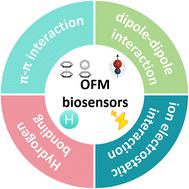当前位置:
X-MOL 学术
›
Biomater. Sci.
›
论文详情
Our official English website, www.x-mol.net, welcomes your feedback! (Note: you will need to create a separate account there.)
Highly-ordered assembled organic fluorescent materials for high-resolution bio-sensing: a review
Biomaterials Science ( IF 6.6 ) Pub Date : 2024-02-24 , DOI: 10.1039/d3bm02070c Zheng Wang 1 , Zilong Chen 1 , Zhenhao Zhang 1 , Hongzhen Wang 1 , Haichang Zhang 1
Biomaterials Science ( IF 6.6 ) Pub Date : 2024-02-24 , DOI: 10.1039/d3bm02070c Zheng Wang 1 , Zilong Chen 1 , Zhenhao Zhang 1 , Hongzhen Wang 1 , Haichang Zhang 1
Affiliation

|
Organic fluorescent materials (OFMs) play a crucial role in the development of biosensors, enabling the extraction of biochemical information within cells and organisms, extending to the human body. Concurrently, OFM biosensors contribute significantly to the progress of modern medical and biological research. However, the practical applications of OFM biosensors face challenges, including issues related to low resolution, dispersivity, and stability. To overcome these challenges, scientists have introduced interactive elements to enhance the order of OFMs. Highly-ordered assembled OFMs represent a novel material type applied to biosensors. In comparison to conventional fluorescent materials, highly-ordered assembled OFMs typically exhibit robust anti-diffusion properties, high imaging contrast, and excellent stability. This approach has emerged as a promising method for effectively tracking bio-signals, particularly in the non-invasive monitoring of chronic diseases. This review introduces several highly-ordered assembled OFMs used in biosensors and also discusses various interactions that are responsible for their assembly, such as hydrogen bonding, π–π interaction, dipole–dipole interaction, and ion electrostatic interaction. Furthermore, it delves into the various applications of these biosensors while addressing the drawbacks that currently limit their commercial application. This review aims to provide a theoretical foundation for designing high-performance, highly-ordered assembled OFM biosensors suitable for practical applications. Additionally, it sheds light on the evolving trends in OFM biosensors and their application fields, offering valuable insights into the future of this dynamic research area.
中文翻译:

用于高分辨率生物传感的高度有序组装有机荧光材料:综述
有机荧光材料(OFM)在生物传感器的发展中发挥着至关重要的作用,能够提取细胞和生物体内的生化信息,并延伸到人体。同时,OFM生物传感器为现代医学和生物学研究的进步做出了重大贡献。然而,OFM生物传感器的实际应用面临挑战,包括分辨率低、分散性和稳定性等问题。为了克服这些挑战,科学家们引入了交互元素来增强 OFM 的顺序。高度有序组装的 OFM 代表了一种应用于生物传感器的新型材料类型。与传统荧光材料相比,高度有序组装的 OFM 通常表现出强大的抗扩散特性、高成像对比度和出色的稳定性。这种方法已成为有效跟踪生物信号的一种有前途的方法,特别是在慢性疾病的非侵入性监测中。本综述介绍了几种用于生物传感器的高度有序组装的OFM,并讨论了导致其组装的各种相互作用,例如氢键、π-π相互作用、偶极-偶极相互作用和离子静电相互作用。此外,它还深入研究了这些生物传感器的各种应用,同时解决了目前限制其商业应用的缺点。本综述旨在为设计适合实际应用的高性能、高度有序组装的 OFM 生物传感器提供理论基础。此外,它还揭示了 OFM 生物传感器及其应用领域的发展趋势,为这一动态研究领域的未来提供了宝贵的见解。
更新日期:2024-02-24
中文翻译:

用于高分辨率生物传感的高度有序组装有机荧光材料:综述
有机荧光材料(OFM)在生物传感器的发展中发挥着至关重要的作用,能够提取细胞和生物体内的生化信息,并延伸到人体。同时,OFM生物传感器为现代医学和生物学研究的进步做出了重大贡献。然而,OFM生物传感器的实际应用面临挑战,包括分辨率低、分散性和稳定性等问题。为了克服这些挑战,科学家们引入了交互元素来增强 OFM 的顺序。高度有序组装的 OFM 代表了一种应用于生物传感器的新型材料类型。与传统荧光材料相比,高度有序组装的 OFM 通常表现出强大的抗扩散特性、高成像对比度和出色的稳定性。这种方法已成为有效跟踪生物信号的一种有前途的方法,特别是在慢性疾病的非侵入性监测中。本综述介绍了几种用于生物传感器的高度有序组装的OFM,并讨论了导致其组装的各种相互作用,例如氢键、π-π相互作用、偶极-偶极相互作用和离子静电相互作用。此外,它还深入研究了这些生物传感器的各种应用,同时解决了目前限制其商业应用的缺点。本综述旨在为设计适合实际应用的高性能、高度有序组装的 OFM 生物传感器提供理论基础。此外,它还揭示了 OFM 生物传感器及其应用领域的发展趋势,为这一动态研究领域的未来提供了宝贵的见解。



























 京公网安备 11010802027423号
京公网安备 11010802027423号